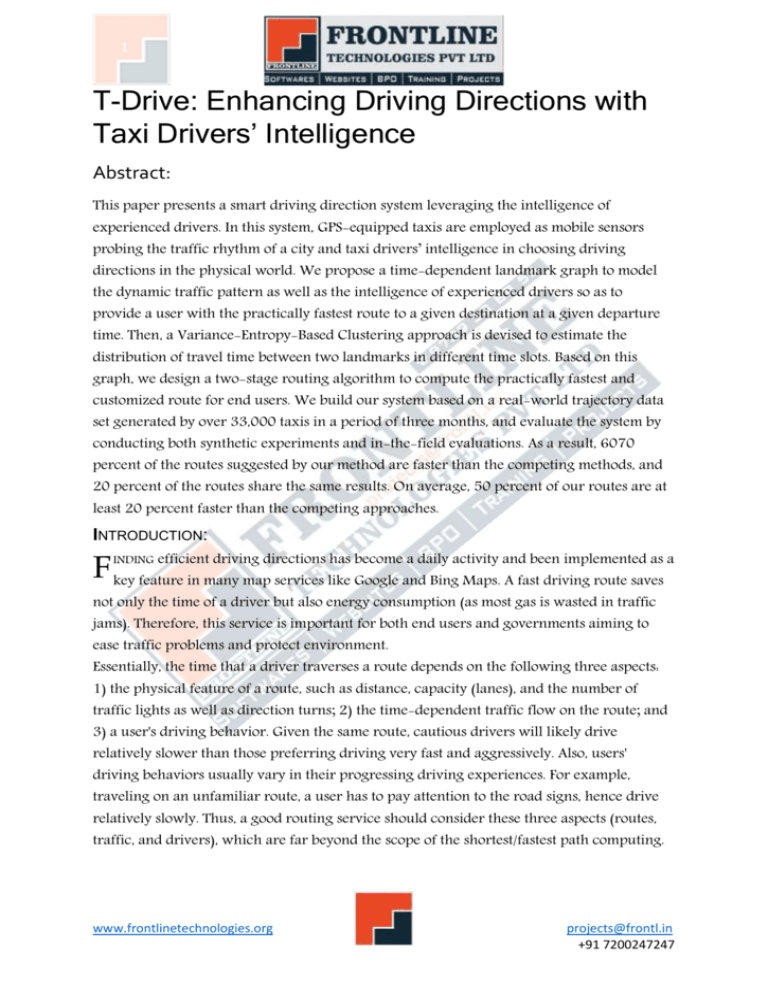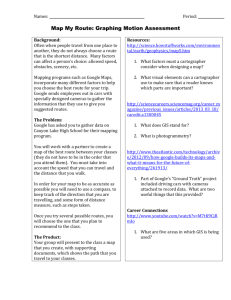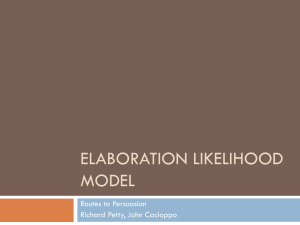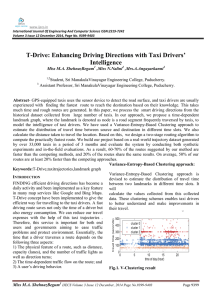T-Drive Enhancing Driving Directions with Taxi Drivers` Intelligence
advertisement

1 T-Drive: Enhancing Driving Directions with Taxi Drivers’ Intelligence Abstract: This paper presents a smart driving direction system leveraging the intelligence of experienced drivers. In this system, GPS-equipped taxis are employed as mobile sensors probing the traffic rhythm of a city and taxi drivers’ intelligence in choosing driving directions in the physical world. We propose a time-dependent landmark graph to model the dynamic traffic pattern as well as the intelligence of experienced drivers so as to provide a user with the practically fastest route to a given destination at a given departure time. Then, a Variance-Entropy-Based Clustering approach is devised to estimate the distribution of travel time between two landmarks in different time slots. Based on this graph, we design a two-stage routing algorithm to compute the practically fastest and customized route for end users. We build our system based on a real-world trajectory data set generated by over 33,000 taxis in a period of three months, and evaluate the system by conducting both synthetic experiments and in-the-field evaluations. As a result, 6070 percent of the routes suggested by our method are faster than the competing methods, and 20 percent of the routes share the same results. On average, 50 percent of our routes are at least 20 percent faster than the competing approaches. INTRODUCTION: efficient driving directions has become a daily activity and been implemented as a F key feature in many map services like Google and Bing Maps. A fast driving route saves INDING not only the time of a driver but also energy consumption (as most gas is wasted in traffic jams). Therefore, this service is important for both end users and governments aiming to ease traffic problems and protect environment. Essentially, the time that a driver traverses a route depends on the following three aspects: 1) the physical feature of a route, such as distance, capacity (lanes), and the number of traffic lights as well as direction turns; 2) the time-dependent traffic flow on the route; and 3) a user's driving behavior. Given the same route, cautious drivers will likely drive relatively slower than those preferring driving very fast and aggressively. Also, users' driving behaviors usually vary in their progressing driving experiences. For example, traveling on an unfamiliar route, a user has to pay attention to the road signs, hence drive relatively slowly. Thus, a good routing service should consider these three aspects (routes, traffic, and drivers), which are far beyond the scope of the shortest/fastest path computing. www.frontlinetechnologies.org projects@frontl.in +91 7200247247 2 Architecture Diagram: CONCLUSIONS: This paper describes a system to find out the practically fastest route for a particular user at a given departure time. Specifically, the system mines the intelligence of experienced drivers from a large number of taxi trajectories and provide the end user with a smart route, which incorporates the physical feature of a route, the time-dependent traffic flow as well as the users' driving behaviors (of both the fleet drivers and of the end user for whom the route is being computed). We build a real system with real-world GPS trajectories generated by over 33,000 taxis in a period of three months, then evaluate the system with extensive experiments and in-the-field evaluations. The results show that our method significantly outperforms the competing methods in the aspects of effectiveness and efficiency in finding the practically fastest routes. Overall, more than 60 percent of our routes are faster than that of the existing online map services, and 50 percent of these routes are at least 20 percent faster than the latter. On average, our method can save about 16 percent of time for a trip, i.e., 5 minutes per 30-minutes driving. References: 1. J. Yuan, Y. Zheng, C. Zhang, W. Xie, G. Sun, H. Yan, and X. Xie, "T-Drive: Driving Directions Based on Taxi Trajectories," Proc. 18th SIGSPATIAL Int'l Conf. Advances in Geographic Information Systems (GIS), 2010. 2. T. Hunter, R. Herring, P. Abbeel, and A. Bayen, "Path and Travel Time Inference from GPS Probe Vehicle Data," Proc. Neural Information Processing Systems (NIPS), 2009. www.frontlinetechnologies.org projects@frontl.in +91 7200247247 3 3. Y. Lou, C. Zhang, Y. Zheng, X. Xie, W. Wang, and Y. Huang, "Map-Matching for Low-Sampling-Rate GPS Trajectories," Proc. Int'l Conf. Advances in Geographic Information Systems (GIS), 2009. 4. J. Yuan, Y. Zheng, C. Zhang, and X. Xie, "An Interactive-Voting Based Map Matching Algorithm," Proc. Int'l Conf. Mobile Data Management (MDM), 2010. 5. E. Kanoulas, Y. Du, T. Xia, and D. Zhang, "Finding Fastest Paths on a Road Network with Speed Patterns," Proc. Int'l Conf. Data Eng. (ICDE), 2006. 6. A. Orda and R. Rom, "Shortest-Path and Minimum-Delay Algorithms in Networks with Time-Dependent Edge-Length," J. ACM, vol. 37, no. 3, pp. 607-625, 1990. 7. N. Leibowitz, B. Baum, G. Enden, and A. Karniel, "The Exponential Learning Equation as a Function of Successful Trials Results in Sigmoid Performance," J. Math. Psychology, vol. 54, no. 3, pp. 338-340, 2010. 8. B.C. Dean, "Continuous-Time Dynamic Shortest Path Algorithms," master's thesis, MIT, 1999. 9. C. Schensted, "Longest Increasing and Decreasing Subsequences," Canadian J. Math., vol. 13, pp. 179-191, 1961. 10. W.S. George and G.C. William, Statistical Methods, eighth ed. Wiley-Blackwell, 1991. www.frontlinetechnologies.org projects@frontl.in +91 7200247247






